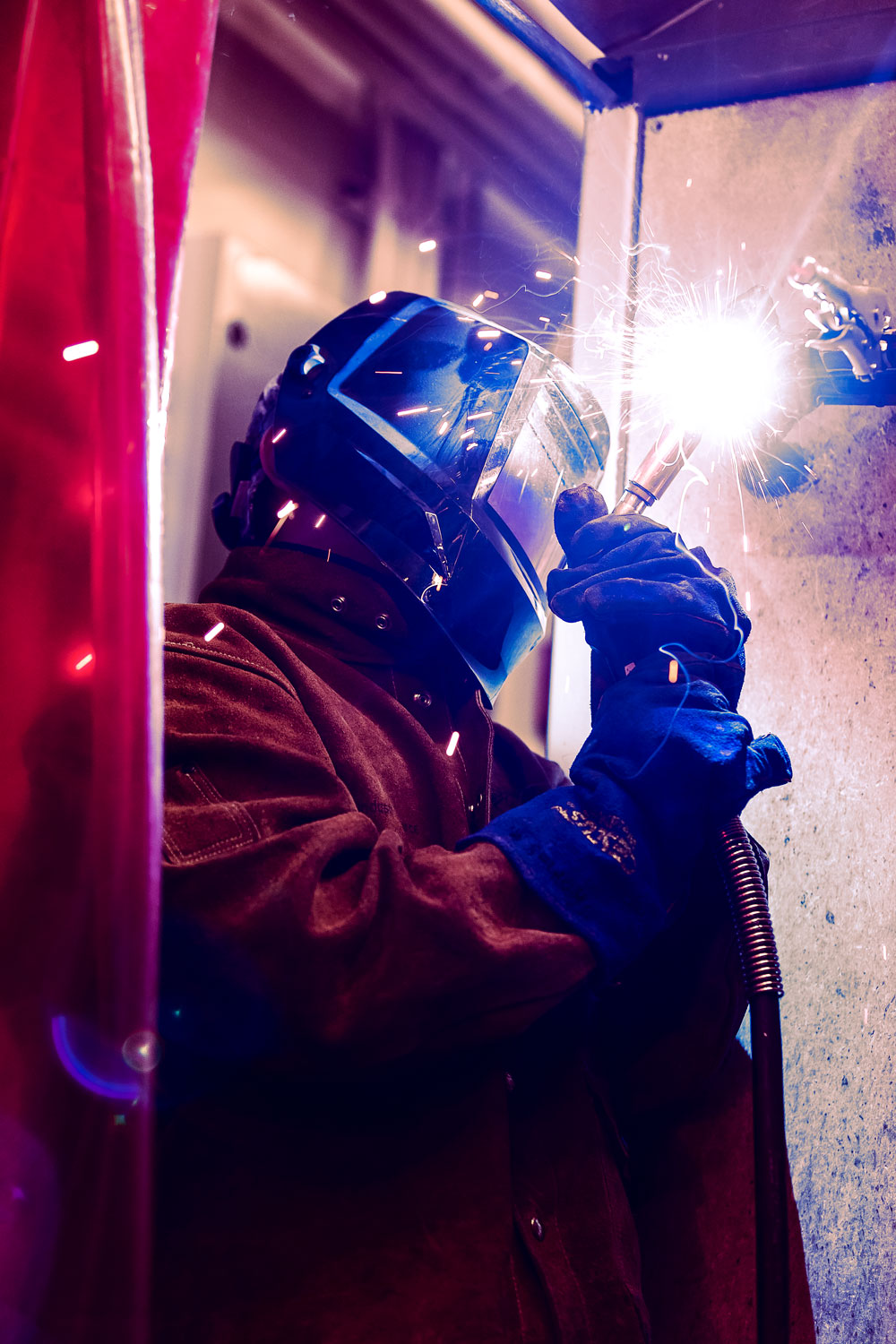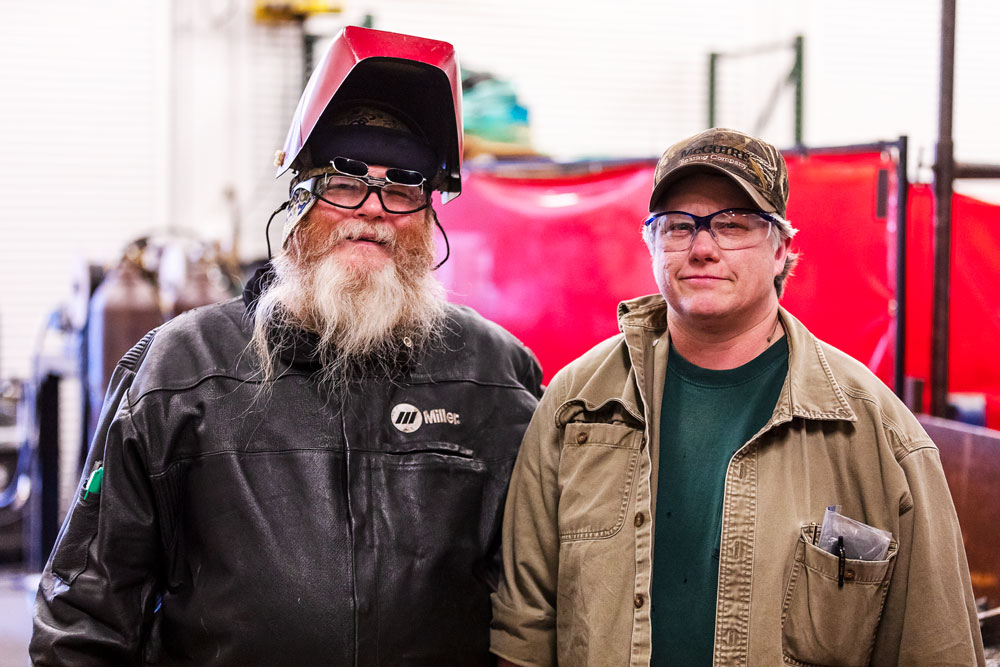WELDING PROGRAM BONDS STUDENTS TO A CAREER PATH

Day cohort student doing an overhead weld with flex core (FCAW) process. Photo by Fletcher Wold / the Advocate
Mt. Hood’s Welding Technology program is on a hot streak.
It has the highest enrollment in a decade, as a result of recruitment efforts, a high demand for skilled workers in the welding trade, and through conscious efforts to make it a barrier-free program.
Program leaders say they’re ready to take in even more students to train.
Rick Walters, welding instructor and coordinator for the program, said, “Anybody can do this. All they have to have is a willingness to learn.”
ENROLLMENT
The welding workforce is in need of new workers, said Val Gilbert, an MHCC alumnus and now a full-time welding instructor. “The AWS (American Welding Society) is saying there’s 250,000 people over the next five-10 years that are going to retire,” said Gilbert.
In recent years, she and others from the campus Integrated Metals programs have frequently gone to local high schools to promote the program. Walters explained that MHCC has a working agreement with some high schools to allow students to earn one credit of welding lab time toward the Mt. Hood certificate program while still in high school.
This has led to some eager students to join the Mt. Hood program before they’ve even graduated high school.
The other big thing that has changed is the welding program having open entry. This is the second year of the change, and Walters and Gilbert agree that it’s helped enrollment. Before, students had to meet certain prerequisites and apply to get in, but now people can pick and choose which welding classes they want to try out. The program also works with Vocational English as a Second Language (VESL) students, so they can learn English and learn new welding skills simultaneously.
The program is home to students of all ages and backgrounds. About 75 students are in welding classes currently, with 45 enrolled in the Welding Technology program. The nine-month program gets students the certifications they need to get to work by learning the AWS’s D1.1 steel structural welding code, which gives them an advantage when applying for jobs.
As Gilbert pointed out, “A welder touches everything: The planes that fly over our heads, vehicles, boats – everything is touched by a welder in some way, shape, or form.” She also explained welding is a skill someone can take anywhere in the world and use to get a job.
GETTING TO WORK
The Welding Technology program has an advisory board with industry leaders who communicate the needs of the industry and local companies to make sure MHCC students are developing the skills needed to match the jobs available to them.
Walters shared the story of a past student with a passion for Gas Tungsten Arc Welding, or GTAW. The student did double the number of projects compared to the average program student because his desire to learn was so strong. Within a year of the student graduating, Walters received a call from a foreign number and when he answered, it was that graduate calling from the Middle East about how he got a job welding boiler plates for nuclear reactors in power plants, and was making roughly $100 an hour.
Gilbert explained how another alumnus who still comes and volunteers to help current students has a job doing seismic upgrades on buildings, another huge area of high demand for welders. Everyone talks about preparing for the big quake, and welders are a big part of making sure our Pacific Northwest buildings and bridges are as stable as possible.

Welding instructors Rick Walters and Val Gilbert.
Photo by Fletcher Wold / the Advocate
DISCOVERING TEACHING
Neither Gilbert nor Walters expected that they would become teachers after discovering their love for welding at two very different points in life.
When Walters was growing up in California, his father started teaching him to weld at age 11. By the time he was 15, he was in business as a welder and said he did all of the steering and gear box reinforcements for the Land Rover Club in Anaheim.
“I discovered at an early age that this could be lucrative, and was excited about it immediately,” he said.
Walters didn’t have plans to teach, but someone else suggested it to him based on his passion and natural skill in showing others how to weld. He pursued that idea and got his degree and lifetime teaching credential from California State University-San Bernardino, and began teaching at Victor Valley College in Victorville, California. There he taught for 20 years part-time, then moved here for the opportunity to become a full-time teacher. He is in his 15th year teaching at MHCC.
Gilbert worked in the lumber industry for 30 years. When the cabinet shop she worked for was going out of business, she realized she needed a change. She lived in the area, so she joined Mt. Hood’s general welding program while still working at the cabinet shop. Walters recognized how interested Gilbert was in welding and asked if she’d considered teaching.
“I just kind of changed gears and started focusing on welding,” said Gilbert. “Got an Associate’s degree here in Integrated Metals, and at Clackamas Community College for welding, and haven’t looked back since.”
She’s in her fourth year of teaching at MHCC, with this being her first year full-time. Walters, on the other hand, is starting to think about retirement.
Asked about her favorite part of teaching, Gilbert said, “Watching the students grow.”
Walters agreed: “The students are where it’s at,” he said. “Many times, an institution may get absorbed in the politics, in the mechanism by which the college grinds onwards, but we always focus on the students, their needs, how they can excel, how they can be just a better person to the people around them.”
He said he’s learned a lot about the needs of people, especially young folks, who really need a mentor or role model as much as they need someone to teach them the skills they need for a job. “We try to be everything we can for what their needs are,” he said.
Walters and Gilbert hope to see new technologies develop in the Mt. Hood program moving forward, because it’s important for students to learn on the most current technology being used in the industry.
As for prospective welding students, Gilbert said, “It looks scary, there’s sparks, there’s flames, but it’s also safe. Once you learn the safety part of it, it’s far less intimidating.”

Thanks so much Cassie! You did a spectacular job with this article, everything “spot on” and accurate, not always the case with so many articles that hit the presses.
Bravo!
Rick Walters